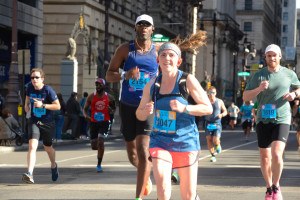Running Q: Do You Really Need to Jog in Place When You’re Stuck at a Light?
Whenever I come to a red light during a run — which happens a lot, as city runs go — I stop dead in my tracks and wait. And I have to admit that whenever I see another runner jogging in place at a red light, I laugh a little bit in my head. Har har! Look at that silly guy, bobbing up and down with nowhere to go. That can’t possibly be doing anything for him …
Er, right? I realized last week, as this exact thought ran through my head for the zillionth time, that I had no idea if it was beneficial or not to jog in place when you’re stuck at a light. Sure, it seems silly, but maybe I’m just a jerk and there really is something to it.
So I called local running coach Marcy Gialdo and posed the question to her. “I’m with you,” she says. “I always find myself laughing, like, what’s the point?”
Gialdo says for most of the runners out there, there’s no point in continuing to jog. Notice, she said most runners. “There is one exception I can think of,” she says, “but it’s only for a very specific kind of workout.”
That exception would be runs in which you’re entire training goal is to keep your heart rate up the entire time; jogging in place at a red light “would be the only way to do it,” Gialdo says. She adds that if she had a client who was doing max heart-rate training, she’d have him run somewhere where he could do so continuously without stopping, like a track.
But for everybody else, stopping is just fine — and may actually be beneficial. “I think being able to stop and start is something you should learn how to do,” she explains. “Stopping is a sign of fitness, of how quickly your heart rate recovers.” The idea is simple: Come to a light and, when you stop, take your pulse. Note how quickly (or not) your heart rate returns to a normal range. The more quickly it adjusts, the better shape you’re in.
Stop-and-start running is also good training for real life race-day scenarios. Think about it: How often do you run a race going the same consistent speed the entire time? With the exception of all you 100-meter dashers out there, I’m going to go ahead and say the answer is close to never. In a real race, you’re slowing down and speeding up to dodge runners in front of you. Maybe you’re walking as you go through the water station, and, hey, maybe you even have to stop mid-race to use a Porta Potty. (It happens!) The point is, if you don’t practice coming allllll the way down and then going alllll the way back up, it could really mess with you come race day.
“Some people think if you don’t run continuously the whole time, it doesn’t count,” Gialdo says, admitting that she used to fall into that trap and would bob in place at red lights. “When I started training with groups of people, it was like, ‘What the hell am I doing?’ You can relax about stopping. It’s really not a big deal.”
Like what you’re reading? Stay in touch with Be Well Philly — here’s how:
- Like Be Well Philly on Facebook
- Follow Be Well Philly on Twitter
- Follow Be Well Philly on Pinterest
- Get the Be Well Philly Newsletter



